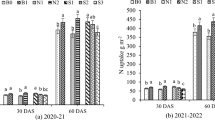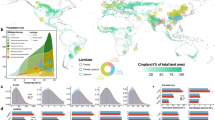Abstract
A field experiment was conducted to investigate effects of tillage practices [no-tillage (NT) and conventional intensive tillage (CT)] and oilseed rape residue returning levels (0, 3000, 6000, 9000 kg dry matter ha−1) on methane (CH4) and carbon dioxide (CO2) emissions and grain yield from paddy fields during the 2011 rice growing season after 2 years oilseed rape-rice rotation in central China. The experiment was established following a split-plot design of a randomized complete block with tillage practices as the main plots and residue returning levels as the sub-plots. NT significantly decreased CO2 and CH4 emissions by 38.8 and 27.3 % compared with CT, respectively. Residue returning treatments released significantly more CO2 and CH4 by 855.5–10410 and 51.5–210.5 kg ha−1 than no residue treatments, respectively. The treatments of 3,000 and 6,000 kg ha−1 residue returning significantly increased rice grain yield by 37.9 and 32.0 % compared with the treatment of no residue returning, respectively. Compared with NT, CT increased yield-scaled emissions of CH4 and CO2 by 16.0 %. The treatments of 6,000 and 9,000 kg ha−1 residue returning significantly increased yield-scaled emissions of CH4 and CO2 by 18.1 and 61.5 %, respectively, compared with the treatment of no residue returning. Moreover, the treatment of NT in combination with 3,000 kg ha−1 residues had the lowest yield-scaled emissions of CH4 and CO2 across tillage and residue treatments. In this way, this study revealed that the combination of NT with 3,000 kg ha−1 residues was a suitable strategy for optimizing carbon emissions and rice grain yield.


Similar content being viewed by others
References
Ahmad S, Li CF, Dai GZ, Zhan M, Wang JP, Pan SG, Cao CG (2009) Greenhouse gas emission from direct seeding paddy field under different rice tillage systems in central China. Soil Till Res 106:54–61
Ali MA, Lee CH, Lee YB, Kim PJ (2009) Silicate fertilization in no-tillage rice farming for mitigation of methane emission and increasing rice productivity. Agric Ecosyst Environ 132:16–22
Baggs EM, Chebii J, Ndufa JK (2006) A short-term investigation of trace gas emissions following tillage and no-tillage of agroforestry residues in western Kenya. Soil Till Res 90:69–76
Bai XL, Zhang HL, Chen F, Sun GF, Hu Q, Li Y (2010) Tillage effects on CH4 and N2O emission from double cropping paddy field. Trans CSAE 26:282–289 (in Chinese)
Ball BC, Scott A, Parker JP (1999) Field N2O, CO2 and CH4 fluxes in relation to tillage, compaction and soil quality in Scotland. Soil Till Res 53:29–39
Bayer C, Costa FDS, Pedroso GM, Zschornack T, Camargo ES, Lima MAD, Frigheto RTS, Gomes J, Marcolin E, Macedo VRM (2014) Yield-scaled greenhouse gas emissions from flood irrigated rice under long-term conventional tillage and no-till systems in a humid subtropical climate. Field Crops Res 162:60–69
Cao GL, Zhang XY, Wang YQ, Zheng FC (2007) Estimation of emissions of agricultural straw open burning in Chinese regional. Chin Sci Bullet 52:1826–1831 (in Chinese)
Chauhan BS (2013) Effect of tillage systems, seeding rates, and herbicides on weed growth and grain yield in dry-seeded rice systems in the Philippines. Crop Prot 54:244–250
Derpsch R, Friedrich T (2009) Development and current status of no-till adoption in the world. In: Proceedings on CD, 18th triennial conference of the international soil tillage research organisation, (ISTRO), Izmir
Derpsch R, Friedrich T, Kassam A, Li H (2010) Current status of adoption of no-till farming in the world and some of its main benefits. Inter J Agric Biol Eng 3:1–25
FAO (1974) FAO soil classification. http://www.en.wikipedia.org/wiki/FAO_soil_classification
Flessa H, Beese F (1995) Effects of sugarbeet residues on soil redox potential and nitrous oxide emission. Soil Sci Soc Am J 59:1044–1051
Guo ZL, Ca CF, Li ZX, Wang TW, Zheng MJ (2009) Crop residue effect on crop performance, soil N2O and CO2 emissions in alley cropping systems in subtropical China. Agrofor Syst 76:67–80
Hanson PJ, Edwards NT, Garten CT, Andrews JA (2000) Separating root and soil microbial contributions to soil respiration: a review of methods and observations. Biogeochemistry 48:115–146
Hütsch BW (2001) Methane oxidation in non-flooded soils as affected by crop production—invited paper. Eur J Agron 14:237–260
IPCC (2007) Climate change 2007-mitigation of climate change: working group iii contribution to the fourth assessment report of the IPCC. Cambridge University Press, Cambridge
IPCC (2014) Climate change 2014-mitigation of climate change: working group iii contribution to the fourth assessment report of the IPCC. Cambridge University Press, Cambridge
Iqbal J, Hu R, Lin S, Hatano R, Feng M, Lu L, Ahamadou B, Du L (2009) CO2 emission in a subtropical red paddy soil (Ultisol) as affected by straw and N-fertilizer applications: a case study in Southern China. Agric Ecosyst Environ 131:292–302
Jain N, Dubey R, Dubey DS, Singh J, Khanna M, Pathak H, Bhatia A (2014) Mitigation of greenhouse gas emission with system of rice intensification in the Indo-Gangetic Plains. Paddy Water Environ 12:355–363
Jiang XJ, Xie DT (2009) Combining ridge with no-tillage in lowland rice-based cropping system: long-term effect on soil and rice yield. Pedosphere 19:515–522
Jiang PK, Xu QF, Xu ZH, Cao ZH (2006) Seasonal changes in soil labile organic pools within a Phyllostachys praecox stand under high rate fertilization and winter mulch in subtropical China. For Ecol Manag 236:30–36
Jones JJB (2001) Laboratory guide for conducting soil tests and plant analysis. CTC Press, Boca Raton, London, New York, Washington, DC, pp 140–142
Li DM, Liu MQ, Cheng YH, Wang D, Jiao JG, Li HX, Hu F (2011) Methane emissions from double-rice cropping system under conventional and no tillage in southeast China. Soil Till Res 113:77–81
Li CF, Zhou DN, Kou ZK, Zhang ZS, Wang JP, Cai ML, Cao CG (2012) Effects of tillage and nitrogen fertilizers on CH4 and CO2 emissions and soil organic carbon in paddy fields of central China. PLoS One 7:e34642
Li CF, Zhang ZS, Guo LJ, Cao CG (2013) Emissions of CH4 and CO2 from double rice cropping systems under varying tillage and seeding methods. Atmos Environ 80:438–444
Liebig MA, Tanaka DL, Wienhold BJ (2004) Tillage and cropping effects on soil quality indicators in the northern Great Plains. Soil Till Res 78:131–141
Liu J, Huang Q, Fu H, Lu XM, Liu HZ, Li KH (2002) Physiological mechanism of high and stable yield of no-tillage cast-transplanted rice. Agric Sci China 1:404–409 (in Chinese)
Liu XJ, Mosier AR, Halvorson AD, Zhang FS (2006) The impact of nitrogen placement and tillage on NO, N2O, CH4 and CO2 fluxes from a clay loam soil. Plant Soil 280:177–188
Lou YS, Li ZP, Zhang TL (2003) Carbon dioxide flux in a subtropical agricultural soil of China. Water Air Soil Pollut 149:281–293
Lu F, Wang XK, Han B, Ouyang ZY, Zheng H (2010) Straw return to rice paddy: soil carbon sequestration and increased methane emission. Chin J Appl Ecol 21:99–108 (in Chinese)
Mosier AR, Halvorson AD, Reule CA, Liu XJ (2006) Net global warming potential and greenhouse gas intensity in irrigated cropping systems in northeastern Colorado. J Environ Qual 35:1584–1598
Naser HM, Nagata O, Tamura S, Hatano R (2007) Methane emissions from five paddy fields with different amounts of rice straw application in central Hokkaido, Japan. Soil Sci Plant Nutr 53:95–101
Pandey D, Agrawal M, Bohra JS (2012) Greenhouse gas emissions from rice crop with different tillage permutations in rice–wheat system. Agric Ecosyst Environ 159:133–144
Plaza-Bonilla D, Cantero-Martínez C, Bareche J, Arrúe JL, Álvaro-Fuentes J (2014) Soil carbon dioxide and methane fluxes as affected by tillage and N fertilization in dryland conditions. Plant Soil 381:111–130
Priemé A, Christensen S (1997) Seasonal and spatial variation of methane oxidation in a Danish spruce forest. Soil Biol Biochem 29:1165–1172
Qin XB, Li YE, Wan YF, Shi SW, Liao YL, Liu YT, Li Y (2012) Effects of straw mulching on greenhouse gas intensity under no-tillage conditions. Trans CSAE 436:210–216 (in Chinese)
Qu HP, He J, Ning WJ, Liu XH, Huang J, Gu MH (2007) Reviews on effects of rice straw application on rice production. Crops 16:9–11 (in Chinese)
Rao DN, Mikkelsen DS (1977) Effect of acetic, propionic, and butyric acids on young rice seedlings’ growth. Agron J 69:923–928
Schuur EA, Trumbore SE (2006) Partitioning sources of soil respiration in boreal black spruce forest using radiocarbon. Glob Chang Biol 12:165–176
Six J, Elliott ET, Paustian K (2000) Soil macroaggregate turnover and microaggregate formation: a mechanism for C sequestration under no-tillage agriculture. Soil Biol Biochem 32:2099–2133
Smith P, Goulding KW, Smith KA, Powlson DS, Smith JU, Falloon P, Coleman K (2001) Enhancing the carbon sink in European agricultural soils: including trace gas fluxes in estimates of carbon mitigation potential. Nutr Cycles Agroecosyst 60:237–252
Streets DG, Yarber KF, Woo JH, Carmichael GR (2003) Biomass burning in Asia: annual and seasonal estimates and atmospheric emissions. Glob Biogeochem Cycles 17:1099
Trumbore S (2000) Age of soil organic matter and soil respiration: radiocarbon constraints on belowground C dynamics. Ecol Appl 10:399–411
Van Der Gon HD, Van Breemen N, Neue HU, Lantin RS, Aduna JB, Alberto MCR, Wassmann R (1996) Release of entrapped methane from wetland rice fields upon soil drying. Glob Bigeochem Cycles 10:1–9
Van Groenigen JW, Velthof GL, Oenema O, Van Groenigen KJ, Van Kessel C (2010) Towards an agronomic assessment of N2O emissions: a case study for arable crops. Eur J Soil Sci 61:903–913
Wang JY, Zhang XL, Xiong ZQ, Khalil MAK, Zhao X, Xie YX, Xing GX (2012) Methane emissions from a rice agroecosystem in South China: effects of water regime, straw incorporation and nitrogen fertilizer. Nutr Cycl Agroecosyst 93:103–112
Wassmann R, Buendia LV, Lantin RS, Bueno CS, Lubigan LA, Umali A, Nocon NN, Javellana AM, Neue HU (2000) Mechanisms of crop management impact on methane emissions from rice fields in Los Banos, Philippines. Nutr Cycl Agroecosyst 58:107–119
Wu X, Yao WY, Zhu J, Miller C (2010) Biogas and CH4 productivity by co-digesting swine manure with three crop residue as an external carbon source. Bioresour Technol 101:4042–4047
Wu J, Guo XS, Zhang XM, Wang YQ (2013) Effects of no-tillage on supply characteristics of soil inorganic nitrogen and rice yield. Sci Agric Sin 46:1172–1181
Xie RZ, Li SK, Li XJ (2007) The analysis of conservation tillage in China: conservation tillage and crop production. Sci Agric Sin 40:1914–1924 (in Chinese)
Yang QP, Xu M, Liu HS, Wang JS, Liu LX, Chi YG, Zheng YP (2011) Impact factors and uncertainties of the temperature sensitivity of soil respiration. Acta Ecol Sin 31:2301–2311 (in Chinese)
Zeng MX, Wang RF, Peng SQ, Zhang YJ, Shan XZ, Liao CZ, Tian YG (2002) Summary of returning straw into field of main agricultural areas in China. Chin J Soil Sci 33:336–339 (in Chinese)
Zou JW, Huang Y, Jiang JJ, Zheng XH, Sass RL (2005) A 3-year field measurement of methane and nitrous oxide emissions from rice paddies in China: Effects of water regime, crop residue, and fertilizer application. Glob Biogeochem Cycles 19:GB2021
Acknowledgments
This work was funded by National Natural Science Foundation of China (31471454), Fundamental Research Funds for the Central Universities (2013PY106), National Technology Project for High Food Yield of China (2011BAD16B02) and Program for Changjiang Scholars and Innovative Research Team in University of China (IRT1247). We sincerely thank two anonymous referees for their critical comments on the original manuscript.
Author information
Authors and Affiliations
Corresponding authors
Rights and permissions
About this article
Cite this article
Zhang, ZS., Cao, CG., Guo, LJ. et al. Emissions of CH4 and CO2 from paddy fields as affected by tillage practices and crop residues in central China. Paddy Water Environ 14, 85–92 (2016). https://doi.org/10.1007/s10333-015-0480-4
Received:
Revised:
Accepted:
Published:
Issue Date:
DOI: https://doi.org/10.1007/s10333-015-0480-4




